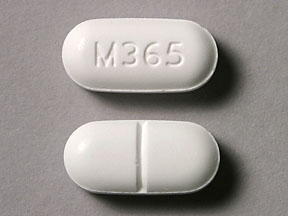M365 Pill
M365 is a white oval pill prescribed to relieve moderate to severe pain severe enough to require an opioid analgesic and for which alternative treatments are inadequate. It contains two active ingredients: acetaminophen and hydrocodone bitartrate. If you have been instructed to take them, it is crucial to understand how it works, its potential side effects, and how to take it safely and effectively.
Each capsule is imprinted with an alphanumeric character on one side and has a crease in the middle, making it easier to divide them. Both ingredients work in different ways and potentiate each other, meaning they increase each other’s impact.
Acetaminophen is also a fever reducer that works by reducing the production of certain chemicals in the body that cause discomfort and inflammation. Hydrocodone is an opioid that works by binding to certain receptors in the brain and spinal cord, blocking the perception of agony.
Each pill contains:
- 325 mg of acetaminophen
- 5 mg of hydrocodone bitartrate

To ensure safe and effective usage, it is important to take them only as directed and to avoid taking more than the recommended amount or for longer than suggested.
M365 are in a classification that act on the nervous system to produce feelings of relief and euphoria. They are highly effective in treating severe discomfort but also carry a high risk for abuse, leading to physical or psychological dependence.
According to the National Institute on Drug Abuse (NIDA), more than 2 million people in the United States have an opioid use disorder. Misuse of prescription opioids can result in overdose, respiratory depression, and even death.
It is important to take this medication only as directed and to notify your provider if you experience any unusual occurrences or if it does not provide adequate relief.
Dosage
This medicine is usually taken every 4-6 hours as needed. The recommended dose is usually one or two, depending on the severity of the discomfort. It is crucial to follow the dosage instructions provided by your doctor.
They can be taken with or without food. If you experience nausea or an upset stomach, try taking them with food or milk.
Side Effects
Like any drug, they can cause other results. The most common ones include:
- dizziness
- drowsiness
- nausea and vomiting
- constipation
- dry mouth
Less common ones may include:
- difficulty urinating
- itching
- rash or hives
- swelling of the face, lips, or tongue
- difficulty breathing
If you experience any of these, notify a medical profession right away.
Class and Availability
This medicine is classified as a Schedule II controlled substance. It is available only by prescription and cannot be purchased over the counter.
Pregnancy Risk
This prescription is classified as pregnancy risk category C, which suggests that its safety during pregnancy is uncertain. If you are pregnant or planning to become pregnant, consult your doctor to assess the benefits and risks of taking this medication.
Inactive Ingredients
Each tablet also contains several inactive ingredients, which may include corn starch, crospovidone, magnesium stearate, microcrystalline cellulose, povidone, and stearic acid. These inactive ingredients do not have any therapeutic effect but may cause allergic reactions in some individuals.
Alternatives
If you are unable to take it or if it does not provide adequate relief, there are several alternatives available for the same conditions. These alternatives can include non-opioid options such as tramadol or ibuprofen. Non-pharmacological treatments like physical therapy, massage therapy, acupuncture, or mindfulness-based stress reduction techniques may also be effective.
Other Information
Availability: Prescription only
Class: Narcotic analgesic combinations
DEA Schedule: CII
Pregnancy Risk: Uncertain
CSA Schedule: High potential for abuse
Addiction and Withdrawal
It is crucial to be aware of the risks associated with its use in terms of addiction and withdrawal.
Addiction occurs when a person develops a compulsive urge to use it despite negative consequences. It is important to take this medication only as prescribed and to monitor your usage carefully. If you find that you are developing a dependency or feel a strong craving to use it beyond the prescribed dose, it is essential to seek help from your doctor immediately.
Abruptly stopping its use, after prolonged or high-dose usage, can result in withdrawal symptoms. Withdrawal occurs as the body adjusts to its absence. Common withdrawal symptoms may include:
- Nausea and vomiting
- Diarrhea
- Sweating
- Muscle aches
- Insomnia
- Anxiety or restlessness
- Irritability
- Tremors
If you need to discontinue taking it, seek guidance on how to taper off gradually to minimize the risk of withdrawal symptoms. It is crucial to follow your instructions and seek support during this process.
If you or someone you know is struggling with addiction or experiencing withdrawal symptoms, it is important to reach out for professional help. There are various resources available, including addiction treatment centers, support groups, and helplines, that can provide assistance and support in overcoming addiction and managing withdrawal symptoms.
Remember, it is always best to prioritize your health and well-being and abide by the guidance and recommendations regarding the use and any associated addiction or withdrawal concerns.
Overall, it is crucial to use them responsibly. If you have any concerns or questions about this prescription, consult your healthcare provider for further clarification.

